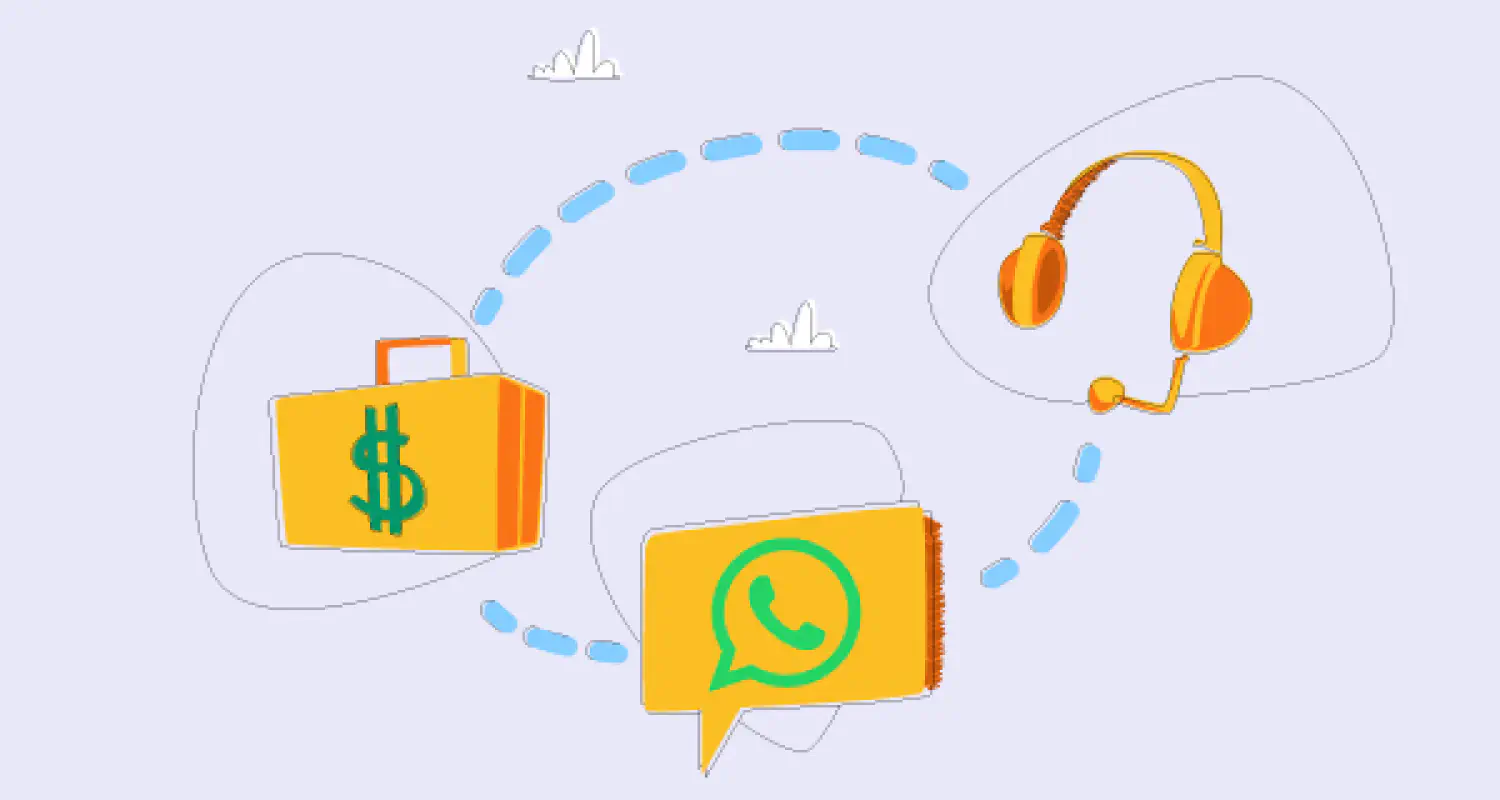How to Collaborate as a Sales and Support Team on WhatsApp

To collaborate as a sales and support team on WhatsApp, you need structure, which consists of clear ownership, shared context, real-time coordination, and the right tools to make it all work at scale.
Without that structure, things don’t go well for your teams. Handoffs between sales and support go cold, and internal confusion slows everything down.
In this article, we’ll walk you through exactly how to fix that.
We’ll start by breaking down what good collaboration looks like in B2B teams and what happens when it’s missing.
Why is sales-support team collaboration important in B2B?
Team collaboration in B2B means different teams coordinating and communicating toward a shared outcome, typically tied to revenue or customer success. It requires alignment around goals, smooth handoffs, and shared visibility into what’s happening with each customer.
Good collaboration depends on three key elements:
- Shared context – Everyone understands the customer’s journey so far
- Clear ownership – It’s obvious who’s doing what, and when
- Real-time coordination – Teams move quickly and in sync, especially during live conversations
When these pillars are in place, your company moves faster, and your customers get a better experience.
In most B2B companies, collaboration needs to happen across multiple teams: sales, customer support, customer success, marketing, and even product. Each team plays a role in converting, activating, or retaining a customer.
But when these teams work independently, customers get a bumpy experience.
We’ll zoom in on two of the most critical teams that need to collaborate daily: sales and customer support. Because they face customers the most, their ability to work as one unit can make or break the customer experience.
What happens when team collaboration breaks down?
When collaboration between teams break, it affects the entire team’s performance and efficiency and might expand enough to affect the customer’s experience. Here’s an overview of what happens:
- Sales reps close the deal, but no one is support knows who’s responsible for follow-up
- Handoffs between sales and support go cold
- Important customer information lives in disconnected WhatsApp chats
- Managers can’t see what’s happening inside conversations
- Customers get double replies or no replies at all
Stats back this up. According to ProofHub, 97% of employers and employees believe that a broken collaboration affects workplace success. That means if you want to meet your business revenue goals, you need good collaboration.
What makes a high-performing WhatsApp team?
A high-performing WhatsApp team is one that coordinates in a single centralized working space, where they can share customer info and data easily and know exactly who’s doing what at each stage of the customer journey.
Here’s what it looks like:
- Centralized communication: All customer conversations happen in one shared inbox
- Clear role ownership: Each conversation has a clear owner, and the whole team knows who’s responsible for what
- Shared access to context: Everyone can see the full history of customer interactions, internal notes, and tags
- Fast, coordinated responses: Behind-the-scenes collaboration that helps teams respond quickly without overlapping or sending mixed messages
- Metrics to track accountability: Managers can monitor performance and track who’s responding, how fast, and where handoffs succeed or fail
How to improve sales team collaboration on WhatsApp
Sales team collaboration on WhatsApp means giving everyone visibility into customer interactions, ownership of specific conversations, and a suitable tech stack and setup.
Here are a few ways to improve collaboration on WhatsApp for sales:
- Assign leads clearly to avoid overlap
- Use internal WhatsApp groups for quick coordination
- Tag conversation status to stay organized
- Make sales data accessible to everyone
- Run daily alignment meetings
And if your WhatsApp setup is integrated with your CRM, things get even smoother. Sales conversations can be logged automatically, lead stages can be updated in real time, and your team gets the visibility and efficiency they need to close deals faster.
How to improve customer service team collaboration on WhatsApp
A collaborating customer support team on WhatsApp works as one unit behind the scenes and looks very organized in front of customers. Escalations happen smoothly, the right teammate steps in at the right moment, and all replies are quick and coordinated.
Here’s how you set up the right collaboration system on WhatsApp:
- Create dedicated team group chats
- Build and maintain an internal knowledge base
- Tag and categorize customer conversations
- Automate repetitive replies
- Centralize customer data and conversations in CRM for smoother handoffs
Building this system will also help you improve by tracking resolution times, escalations, and overall team performance.
Why sales and support should work together on WhatsApp
Sales and support should work as one because they’re responsible for all stages of the customer journey. Sales brings customers in, and support retains them. Working together gives customers a better experience.
Let’s break down why sales and support collaboration matters and how to make it work.
Why handoffs matter
Handoffs between sales and support are a major part of the customer’s experience. Once sales close a deal, the customer expects a smooth transition from sales to support, and they want to see results as soon as possible.
When handoffs go wrong, like no one following up or asking the same questions twice, customers lose trust before they’ve even begun.
How handoffs between sales and support work
A sales-support workflow on WhatsApp needs the following tools to work:
- Shared inbox: So everyone sees the same conversation
- CRM integration: To sync deal and customer data automatically
- Internal notes: To pass context invisibly, without confusing the customer
- Defined handoff logic: So there’s no “who owns this?” moment
With a shared inbox and WhatsApp in place, the handoff can go like this:
- A deal is marked as closed, triggering the entire process
- Data sync happens between sales and support
- Support get all the context they need and get assigned the conversations
- Managers track sales and support performance metrics
The right metrics to track here are time to handle, CSAT, churn rate, and follow-up time. These will show you how smooth the workflow was and what needs improving.
When these handoffs go smoothly, everything else follows.
- Sales → Support: A smooth handoff helps customers onboard faster and stick around longer
- Support → Sales: Support conversations surface upsell opportunities and reveal why deals succeed or fail
Limitations of WhatsApp Business App for team collaboration
The WhatsApp Business App has many limitations for team collaboration, as it was built for small teams. It lacks a lot of features needed for sales and support collaboration, like a shared inbox, assigning conversations, monitoring dashboards, and more.
Here’s what’s missing:
Sales and support conversations are stuck in private chats
When messages live on personal devices, no one else on the team can step in or see what’s already been said.
Updates are manually copy-pasted into Slack, CRMs, or spreadsheets
This slows everything down, introduces errors, and takes time away from actual customer work.
There’s no way to track ownership or conversation stage
Without assignments or statuses, it’s unclear who’s responsible for following up.
Managers have no visibility into what’s happening
There’s no way to monitor response times, track performance, or know which chats are being dropped.
No shared visibility for the team
Team members can’t see each other’s conversations, which leads to duplicated work and missed context.
No internal coordination tools
You can’t leave internal notes, mention teammates, or collaborate behind the scenes, so everything happens in separate chats or apps.
No automation
Every task has to be done manually, which gets messy fast.
It’s hard to scale across multiple agents
The more people you add, the more chaotic it becomes. Without a shared system, you hit a ceiling quickly.
How the WhatsApp Business Platform is better for teams
While the WhatsApp Business App targets small teams, the WhatsApp Business Platform was built to help large teams collaborate. It turns WhatsApp from a personal messaging tool into a shared, structured workspace, complete with visibility, accountability, and automation.
Here’s how it solves the most common collaboration challenges:
| Collaboration feature | Needed for | Available via Rasayel (on WhatsApp Business Platform) |
|---|---|---|
| Auto-routing + clear assignees | Avoiding ownership confusion | Fully supported |
| Internal notes + CRM sync | Preserving context across teams | Fully supported |
| Shared inbox + role-based permissions | Keeping conversations organized and secure | Fully supported |
| Automation + labels + views | Speeding up handoffs and reducing manual work | Fully supported |
| Dashboards + filters + metrics | Giving managers visibility into performance | Fully supported |
Conclusion
Collaboration between sales and support on WhatsApp can make or break the customer journey. When these teams work in sync, handoffs feel smooth, response times drop, and customers stay engaged long after the deal is closed.
We’ve covered what strong collaboration looks like, why it often breaks down, and how the right structure can fix it. While the WhatsApp Business App has its limits, the WhatsApp Business Platform paired with a shared inbox like Rasayel gives your team the tools they need to work together at scale.

Hania is a seasoned researcher and content writer specializing in WhatsApp Business and its role in B2B sales and customer engagement. With years of experience creating in-depth, thought-provoking content, she combines real-life use cases and deep industry insights to help businesses leverage WhatsApp as a growth tool. Her expertise lies in translating complex research into actionable strategies, making her a trusted resource for companies looking to innovate their communication and sales processes.



